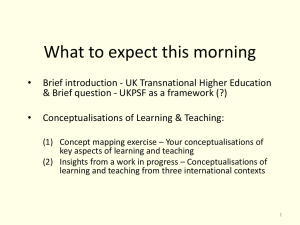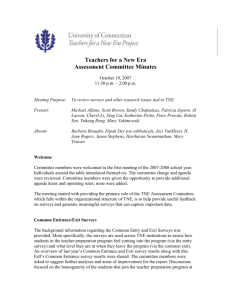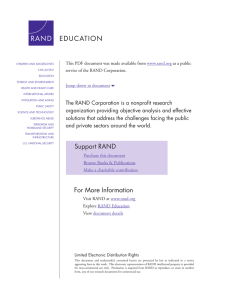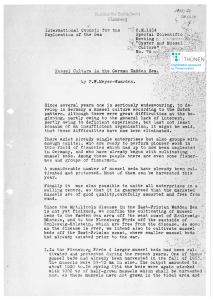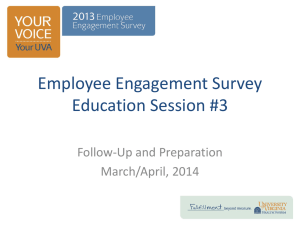W O R K I N G Implementing
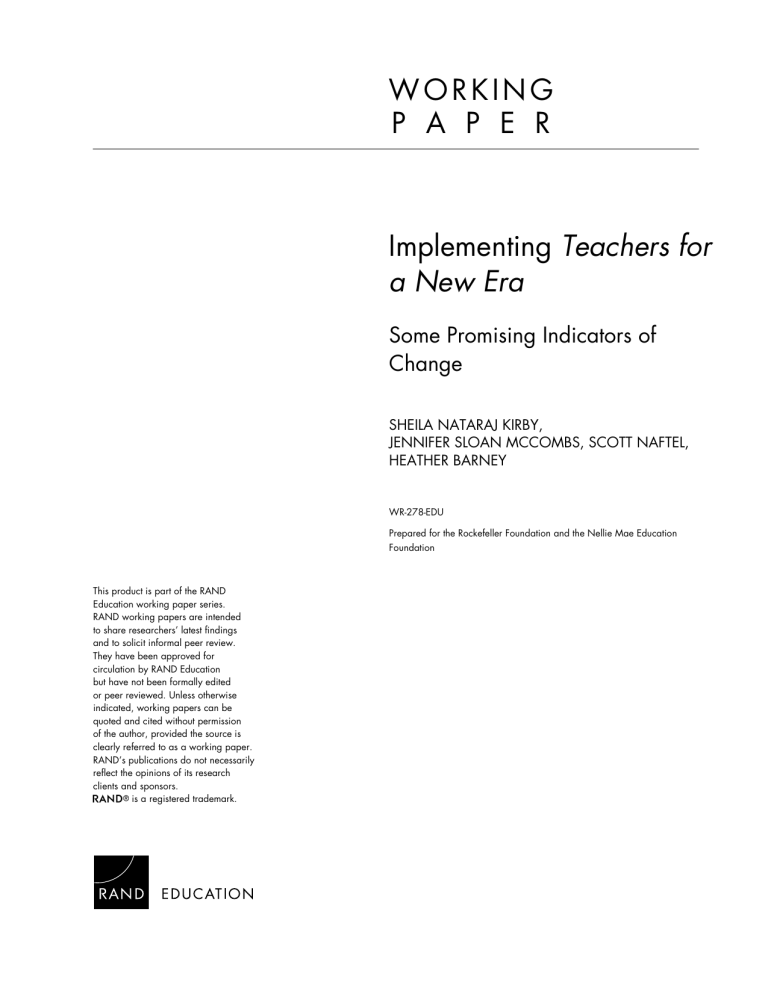
This product is part of the RAND
Education working paper series.
RAND working papers are intended to share researchers’ latest findings and to solicit informal peer review.
They have been approved for circulation by RAND Education but have not been formally edited or peer reviewed. Unless otherwise indicated, working papers can be quoted and cited without permission of the author, provided the source is clearly referred to as a working paper.
RAND’s publications do not necessarily reflect the opinions of its research clients and sponsors.
is a registered trademark.
W O R K I N G
P A P E R
Implementing
Teachers for a New Era
Some Promising Indicators of
Change
SHEILA NATARAJ KIRBY,
JENNIFER SLOAN MCCOMBS, SCOTT NAFTEL,
HEATHER BARNEY
WR-278-EDU
Prepared for the Rockefeller Foundation and the Nellie Mae Education
Foundation
I. INTRODUCTION
1
In the summer of 2001, the Carnegie Corporation of New York announced an ambitious reform initiative, Teachers for a New Era (TNE), to stimulate construction of excellent teacher education programs at selected colleges and universities. In its prospectus, Carnegie made clear that it was seeking “a catalytic revision of teacher education led by colleges and universities committed to a new future for teaching and learning in the nation’s schools.” 1 In order to assist institutions in this endeavor, Carnegie planned to make awards in the amount of $5 million over a period of five years to a number of institutions of higher education. In the first year of the initiative, two other foundations—the Ford Foundation and the Annenberg Foundation—joined Carnegie in funding a total of four institutions: Bank Street College of Education; California State University,
Northridge (CSUN); Michigan State University (MSU); and University of Virginia (UVa). The awards were announced in April 2002. In April 2003, Carnegie made awards to an additional seven institutions—Boston College, Florida A&M University, Stanford University, University of
Connecticut, University of Texas—El Paso, University of Washington, and University of
Wisconsin—Milwaukee.
RAND and Manpower Demonstration Research Corporation (MDRC) are jointly conducting an evaluation of TNE at the first four sites, funded by the Rockefeller Foundation. Building on that evaluation, the Nellie Mae Education Foundation asked RAND and MDRC to evaluate the implementation of TNE at Boston College (BC) and University of Connecticut (UConn). The long-term objectives of the evaluations are to provide evidence of whether the initiative has been
“successful” both from the individual institution’s point of view and that of the funders; to identify factors that foster or hinder the implementation of reform of teacher education programs at the program, institution, district, and state levels; and to promote an understanding of the many factors and actors that need to be aligned in order to successfully reform teacher education and improve student learning. In the short-term, the evaluation seeks to address the following two research questions: x To what extent did the grantees implement Carnegie’s design principles (including the induction program) and other principles laid out in the prospectus?
2 What did the grantees attempt to do with the Carnegie funds? x What factors fostered or hindered implementation?
Purpose of this Paper
Earlier reports have documented the progress of implementation of TNE in the six sites. These include: x A technical report and research brief on first year implementation in the first cohort of grantees (Bank Street, CSUN, MSU, and UVa) 3 x Four specific research briefs discussing the policy context of the four states where these institutions are located 4
1 http://www.carnegie.org/sub/program/teachers_prospectus.html.
2 These are described in Appendix A.
3 Kirby, S. N., McCombs, J. S., Naftel, S., Barney, H., Darilek, H., Doolittle, F., & Cordes, J. (2004). Reforming teacher education: A first year progress report on Teachers for a New Era . TR-149-EDU. Santa Monica, CA:
RAND Corporation. ( http://www.rand.org/publications/TR/TR149/ ); Kirby, S. N., McCombs, J. S., & Naftel,
S. (2004). Reforming Teacher Education: A first year progress report on Teachers for a New Era . RB-9063-EDU.
Santa Monica, CA: RAND Corporation. ( http://www.rand.org/publications/RB/RB9063/ ).
2
x A project memorandum documenting the major activities that Bank Street, CSUN, MSU, and
UVa undertook during the second year of the TNE grant (October 2003-September 2004) 5 and x A project memorandum highlighting the activities undertaken by Boston College and
University of Connecticut in their first year of implementation (September 2003-September
2004).
6
This paper seeks to pull together and highlight some promising indicators of change and innovative activities in the six sites over this time period. Note that Bank Street, CSUN, MSU, and UVa have been implementing TNE for two years, while BC and UConn had completed only one year of implementation.
7 We attempted to select some unusual or particularly noteworthy aspect of each site’s implementation in order to provide a flavor of the kinds of activities being implemented, but this discussion is not meant to be exhaustive, simply illustrative of the kinds of change being brought about by TNE. We focus on implementation progress in three main areas—induction; engagement with arts and sciences; and evidence for program improvement and for measuring the impact of teacher education programs on pupil learning gains.
Caveat
Obviously, the sites are still early in their implementation activities and many of the steps being undertaken are preliminary or exploratory. There is no evidence that a particular activity is effective in improving teacher education and it is far too early to judge whether TNE is achieving what it set out to do. However, some of the culture changes as evidenced by the conversations between arts and sciences, K-12, and education faculty and the attention being paid to gathering evidence about the preparation of teacher candidates are in themselves interesting and noteworthy. As we discuss later, whether these activities will be sustained beyond the life of the grant remains an open question.
Data
This report is primarily based on data collected during annual site visits to each college or university. Each site visit encompassed interviews with the project officer and President/Provost; interviews with the Deans of the Colleges of Education and Arts and Sciences; interviews and focus groups of faculty from both colleges who are involved in teacher education and TNE; meetings with university supervisors and clinical supervisors at the partner schools who oversee
4 Kirby, S. N., McCombs, J. S., & Naftel, S. (2004). Reforming Teacher Education: Spotlight on the University of
Virginia . RB-9062-EDU. Santa Monica, CA: RAND Corporation.
( http://www.rand.org/publications/RB/RB9062/ ); Kirby, S. N., McCombs, J. S., & Naftel, S. (2004). Reforming
Teacher Education: Spotlight on Michigan State University . RB-9061-EDU. Santa Monica, CA: RAND
Corporation. ( http://www.rand.org/publications/RB/RB9061/ ); Kirby, S. N., McCombs, J. S., & Naftel, S.
(2004).
Reforming Teacher Education: Spotlight on California State University, Northridge . RB-9060-EDU. Santa
Monica, CA: RAND Corporation. ( http://www.rand.org/publications/RB/RB9060/ ); Kirby, S. N., McCombs,
J. S., & Naftel, S. (2004). Reforming Teacher Education: Spotlight on Bank Street College of Education . RB-9059-
EDU. Santa Monica, CA: RAND Corporation. ( http://www.rand.org/publications/RB/RB9059/ ).
5 Kirby, S. N., McCombs, J. S., Naftel, S., Darilek, H., & Barney, H. (2005). Implementing Teachers for a New
Era: Second year progress report. PM-1817-EDU. Santa Monica, CA: RAND Corporation.
6 McCombs, J. S., Naftel, S., & Kirby, S. N. (2005). Teachers for a New Era: First year implementation progress at
Boston College and University of Connecticut . PM-1791-EDU. Santa Monica, CA: RAND Corporation.
7 In fact, BC did not receive TNE funds until January 2004 and UConn did not receive its TNE funds until
April 2004. Thus, the first “year” of implementation was actually nine months and six months respectively.
3
clinical experiences; and interviews/focus groups with principals and teachers in partner K-12 schools. These interviews used semi-structured protocols that were shared with the sites prior to the site visit.
4
II. SELECTED HIGHLIGHTS OF TNE IMPLEMENTATION PROGRESS
INDUCTION
5
D e velo p ed an in d u ctio n w eb site w ith “yello w p ag es,” B an k
S treet related activities, an d h elp fu l tip s fo r n ew ed u cato rs
P lan n ed first o f a series o f in d u ctio n e ven ts
C o u n ts as co n tin u in g p ro fes sio n al d e velo p m en t cre d it fo r state
P lan n ed “ Alu m n i M atch in g P ro g ram ”
H ired fu ll-tim e in d u ctio n co o rd in ato r in co n ju n ctio n w ith th e d istrict
P lan n ed in d u ctio n p ro g ra m fo r all n ew teach ers in tw o lo cal d istricts
S elected an d train ed m en to rs
In d u ctio n activitie s le ad in g to n ew relatio n sh ip b etw een
“tow n ” an d “g ow n ”
1
Bank Street
Bank Street launched a number of activities in the area of induction, despite having a change in the induction leadership. In Year 2, Bank Street: x Developed an induction website, called “Transitions for New Educators”
(www.bankstreet.edu/neweducators) that contains “yellow pages” of helpful web resources, announcements for Bank Street-related activities, and tips and advice for new educators contributed by several teachers. x Planned the first of a series of induction events (held September 2004) on incorporating arts in education in the age of accountability and assessment. The event was held at the Lincoln
Center Institute, and Bank Street was able to ensure that this counted as continuing professional development for the participants. x Planned an “Alumni Matching Program,” in which Bank Street will match its alumni with new teacher graduates on the basis of interest and geographical location. Bank Street received a substantial number of alumni volunteers for this program, upon the initial announcement.
UVa
UVa has been successful in establishing collaborative relationships with its two local districts. x While the full-time induction coordinator spearheading this work is a UVa TNE hire, UVa invited local principals and district officials to interview the candidates for this position. x In collaboration with the local districts, UVa planned an induction program for all new teachers in two local districts, based on the Santa Cruz New Teacher Center model—a program that met state requirements for induction.
6
x During the summer of Year 2, UVa and the districts selected and trained the teacher mentors, so the program would be up and running at the beginning of the 2004-2005 school year. x Faculty members noted that the work around induction has formed a new relationship between the university and the districts—now the university is asking what the districts want and need and how it can help.
C reated p ilo t 60-d a y m e n to r p ro g ram fo r recen t g rad u ates
In co o p era tio n w ith fo u r K -12 B P S teach ers w h o atten d ed sem in ar at th e N ew T each er C en ter
D evelo p ed an d h e ld w o rksh o p fo r m en to r tra in in g
(Ju ly)
D evelo p ed an d h e ld tw o-d a y “S u m m er S tart” se m in ar fo r B P S teach ers
H ired fo u r B P S teach ers as c lin ical m en to rs to s u p p o rt b o th n ew teach ers an d m en to r teach ers fo r S Y 2 004-
2005
F irst in a series o f T N E sem in ars d e vo ted to tea ch in g an d in d u c tio n
2
BC
Despite not receiving TNE funding until January 2004, BC made progress in the area of induction. x BC planned a 60-day pilot mentor program for new teachers in Boston Public Schools. In order to provide support for teachers who would be acting as mentors, the TNE induction director and four teachers created a mentor training workshop that was held at BC in July.
These four teachers are now clinical faculty charged with supporting new teachers from BC and mentor teachers and coaches who are working with them. x BC held a two-day seminar for new BC teacher graduates on general topics (such as how to effectively organize a classroom, how to respond to inappropriate behavior) as well as subject and grade specific discussions, and paired them with mentors. x In August, BC hosted induction training for more than 300 new BPS teachers, most of whom were not BC graduates. x The TNE leadership team has planned a series of TNE seminars in order to inform the larger university community about TNE activities. The first TNE seminar was devoted to teaching and induction.
7
II. SELECTED HIGHLIGHTS OF TNE IMPLEMENTATION PROGRESS:
ENGAGEMENT OF ARTS AND SCIENCES AND K-12 PARTNERS
8
P artn ered w ith T E R C , th e N atu ral H isto ry M u s eu m , a n d S arah
L aw ren ce C o lleg e
Arts an d scien ce s p artn ers s erve o n a ctio n -o rien ted in q u iry team s
N ew facu lty reco g n itio n o f th e im p o rtan ce o f co n ten t in q u ality teach in g
A sk ed p artn ers to d e velo p sp e cific scien ce co u rs e fo r in co m in g elem en tary ed u catio n g rad u ate stu d en ts
P ro vo st’s As se ssm en t S e m in ars en g ag e ed u catio n an d arts an d scien c es fa cu lty in d iscu s sio n aro u n d as sessm en t issu es in teach er ed u catio n
H eld at lu n ch at P ro vo st’s h o m e o n c am p u s
C reatin g n ew co u rses in arts an d s cien ce s an d ed u c a tio n
3
Bank Street x Bank Street is using Action Oriented Inquiry teams to collect evidence on its program in order to promote continuous improvement. These teams consist of Bank Street faculty,
School for Children faculty, and arts and sciences faculty from outside partners (described below). In Year 2, the teams focused on English, mathematics, and science and observed student teachers, new teachers, and experienced teachers in order to collect data on teacher practice across a range of career points. x To promote engagement with arts and sciences faculty, Bank Street has partnered with TERC, the Natural History Museum, and Sarah Lawrence College to bring in arts and sciences content experts. These outside content experts have been members of and advisors for the
Action-Oriented Inquiry teams. x These partnerships have shifted the culture and outlook of Bank Street faculty involved in the
Action Oriented Teams. For instance, at the beginning of TNE, some faculty members questioned the value that a content expert would bring to the work of examining quality teaching—believing that content had little to do with quality teaching. However, those faculty members now regularly seek the input and advice of the content partners and conceive of teaching in a different way, which includes the ability to understand and communicate content. x In addition, Bank Street asked a Sarah Lawrence faculty member and Natural History
Museum representative to jointly develop a science content course for Bank Street teacher education candidates coming into the college needing to take a science course.
UVa x The Provost hosts monthly Assessment Seminars at his home on the historic lawn, which engage both education and arts and sciences faculty in lively discussion around assessment issues. In essence, UVa has developed arts and sciences faculty interest in teacher education
9
by appealing to their nature as researchers and scholars and presenting questions and problems to be discussed and solved. x In addition, UVa’s faculty have created a number of new courses, including the Common
Courses and Counterpoint Seminars. x Common Courses are large survey courses in the arts and sciences with an interdisciplinary focus. The goal is to create a course that would provide a good foundation for an elementary school teacher around certain topics. The first TNE common course, Designing Matter, was taught in Year 2, and UVa expects to have three others in Year 3. x Counterpoint Seminars, taken by BA/MT students, are linked to an arts and sciences survey course and focus on how that course’s content can best be taught in a middle school or high school setting. In Year 2, UVa offered the first two counterpoint seminars in English and in history.
T N E h ire s in th e Arts an d S cien ces
S tu d y g ro u p s to e xam in e p ed ag o g ical co n ten t kn o w led g e (P C K )
H isto ry p ro fes so rs d evelo p ed lab fo r h isto ry co u rs e fo cu sed o n
P C K
W o rkin g w ith co m m u n ity co lleg e s to im p ro ve rig o r o f g en eral ed u c atio n co u rs es
A& S an d ed u c atio n facu lty jo in tly d e velo p ed T ea ch er
K n ow led g e S tan d ard s in c o n ten t area s
C o n d u ctin g cu rricu lar e xp erim en ts in scien c e an d m ath em atic s co u rs es to u s e fo r p ro g ram im p ro vem en t
N ew co u rsew o rk req u irem en ts in tro d u ced after revie w — statistics fo r elem en tary m ath em atic s tea ch er can d id ates
4
CSUN
In Year 2, CSUN set a goal to move from “involvement” of arts and sciences faculty with TNE to
“engagement” of arts and sciences faculty with TNE. Apart from specifically hiring new arts and sciences faculty to work part-time on TNE—faculty who were specifically chosen for an interest in K-12 education and pedagogy, CSUN is undertaking the following activities to accomplish this goal: x Holding workshops for arts and sciences faculty that focus on introducing faculty to TNE and describing ways that arts and sciences faculty can become involved.
10
x Holding discussion groups focusing on subject matter and pedagogical content knowledge in mathematics, social sciences, English, science, kinesiology, and arts, often facilitated by TNE hires. The mathematics study group was the first such group and was created by faculty members themselves (not a TNE-directed activity) due to their interests. The other disciplines consider this group a model for these activities. x Reviewing General Education courses to make the transition from community colleges seamless so as to improve the content knowledge of transfer students and improve retention.
They have established a close partnership with their feeder community colleges. x Mounting a three-year data collection effort to examine pedagogical content knowledge
(PCK) throughout the pathways of candidates. This year student and instructor surveys have been fielded, next year they will conduct focus groups with students.
MSU x The arts and sciences and education faculty teams jointly developed Teacher Knowledge
Standards (TKS) in content areas and are using these standards to examine coursework and pedagogy. For example, the faculty reviewed coursework for elementary mathematics teacher candidates and developed a new course in statistics to fill a gap they uncovered. x In addition, arts and sciences faculty members are conducting curricular experiments by aligning courses with TKS and measuring the impact on student understanding. For example, faculty are collecting pre- and post-data on the use of technology clickers in an introductory science course to do ongoing assessment in the classroom and using pre- and post-assessments to track the impact of pedagogical changes in a linear algebra class.
E lem en tary E d u c atio n T ea m ex am in ed co u rs es/exp e rien c es fo r elem en tary s ch o o l teac h ers
S e co n d ary H u m an itie s an d S o cial S cien ce s T e am re cru ited an d train ed five E n g lish fa cu lty an d th ree h isto ry fa c u lty to serve as m en to rs fo r stu d e n t teach ers an d b eg in n in g teach ers
R evised scien c e ed u catio n co u rs es
H ired tw o ten u re-track fac u lty in arts an d scien c es (E n g lish an d m o d ern lan g u ag es)
C u rricu lu m d e sig n co m m ittee co o rd in atin g acro ss d ep artm en ts to w o rk w ith p re-ed u catio n stu d en ts
D evelo p in g lab sectio n fo r T E stu d en ts in so m e h isto ry & m ath em atic s co u rse s
5
BC x The Humanities and Social Sciences Team recruited and trained five English faculty and three history faculty to serve as mentors for student teachers and beginning teachers.
11
x Arts and sciences and education faculty members from the elementary education group conducted focus groups with graduating seniors and are examining identified courses offered in the College of Arts and Sciences that were taken by pre-service elementary education teachers over the past five years. x The Secondary School Science and Mathematics Team studied a sequence of two geology courses and conducted pre-post tests to determine the impact of the courses. The group also made revisions to two science education methods courses (one elementary and one secondary), which are taught on-site at K-12 public schools.
UConn x UConn hired two tenure-track faculty in English and modern and classical languages. These new hires are expected to spend at least 25 percent on TNE—somewhat unusual in a research university. x The modern and classical languages hire is co-teaching a methods course in foreign language instruction with a teacher education professor; the course is co-listed across the two departments. x The Curriculum Design Team is tasked with coordinating with the honors program, English department, and others to work with pre-education students. x A history professor on the Curriculum Design Team is developing a lab section focused on pedagogy for a history course that all teacher education students are required to take.
A ctively In volvin g K 12 F aculty: B C
K -12 fa cu lty actively in vo lved in w ritin g th e p ro p o sa l
K -12 fa cu lty active m em b ers o f all T N E team s , in clu d in g lead ers h ip tea m
R e cru ited K -12 tea ch ers to co -teach s c ien ce c o u rs es o n site at lo ca l sch o o ls
H e lp ed d esig n p ilo t in d u ctio n p ro g ram an d tra in in g fo r m en to rs
F o u r tea ch ers h ired as c lin ical m en to rs to p ro vid e su p p o rt fo r m en to rs an d n e w teach ers
6
BC
The collaboration with K-12 partners and their involvement in the TNE leadership and committees at BC is unique among the sites. BC faculty spoke highly of the involvement of the
12
K-12 representatives, and the K-12 faculty with whom we spoke said that they feel valued as collaborative partners. Both parties seem to feel they have much to gain from the relationship. x BC involved K-12 faculty in writing the TNE proposal, to gain “buy-in” and establish a partnership from the start. x K-12 representatives are included on all TNE teams, including the Leadership Team. x K-12 teachers are co-teaching science courses for teacher education students with arts and sciences professors. These two courses are taught on-site at local schools. x BC hired K-12 teachers to serve as support for mentors in the pilot induction program. These teachers also helped design the program. When we spoke with these teachers they expressed excitement at engaging with the university in this way and noted that these types of activities make the teaching profession more interesting and dynamic.
13
II. SELECTED HIGHLIGHTS OF TNE IMPLEMENTATION PROGRESS:
EVIDENCE
14
TNE requires that the sites gather evidence for two purposes: to make program improvements and to evaluate the effectiveness of the program by measuring the effectiveness of their teacher education graduates, as measured by their ability to improve pupil achievement. Below we highlight the different methods the sites are adopting to measure the effects of their programs.
USING EVIDENCE FOR PROGRAM IMPROVEMENT
Created Action-Oriented Inquiry teams to conduct structured observations of student teachers, new teachers, and experienced teachers
Selected instrument to measure the continuum of teaching
Building a coordinated database on TE candidates
Identified three clinical sites as PDSs
Creating digital assessment files for each TE candidate
Reviewing content courses and general education courses to determine appropriateness and efficacy of courses
Teacher education candidates to participate in research studies for program improvement
Examined dual placement and single placement student teaching experiences
6
Bank Street x As described earlier, Bank Street has created Action Oriented Inquiry teams to study the practice of teacher candidates, new teachers, and experienced teachers. Data are coded and analyzed in order to inform program renewal and ensure that it is evidence-based. The findings of the AOI project will help inform admissions, the induction program, and their teacher leader program. x Bank Street is also examining “curriculum-embedded” assessments. This method involves looking at the actual tasks teachers assign pupils and how the pupils respond to those tasks.
Under this method, assigned tasks are analyzed in terms of the kinds of demands they place on children. Then the actual pupil responses to those tasks are analyzed for complexity, level of sophistication, and completeness. In Year 2, Bank Street selected a taxonomy model that would allow them to conduct this analysis. Bank Street will pilot the use of this instrument in Year 3 and will sample and study graduates in Year 4.
CSUN x CSUN is developing an integrated database containing data on its students from all sources, that will allow them to track course-taking patterns, grades, and field experiences of their teacher education candidates as they progress through the program.
15
x CSUN is working with three clinical sites to help them become professional development schools. These schools will become labs, where courses will be taught onsite and evidence collected regarding teacher candidate and pupil learning.
MSU x MSU is creating digital assessment files for each teacher education candidate that incorporate student work and rubrics in teacher education and disciplinary courses to determine the efficacy of these courses. x MSU is also examining the rigor and appropriateness of the general education courses taken by teacher education and non-teacher education students.
UVa x UVa’s Assessment Team worked to establish a Curry student participant pool and instruments for studies that will track the progress of these Curry students throughout the teacher education program. The teacher education department is instituting a requirement that all newly enrolled students must complete five hours of research studies or alternate assignments per year for the term of the teacher education program. Students who join the research pool will be asked to release core data including high school and college transcripts,
SAT scores, PRAXIS scores, and GRE scores. x UVa conducted a study that examined dual placement and single placement student teaching experiences. Data from the dual placement-single placement study showed that the single placement led to outcomes that were more highly desired by the Curry faculty (greater involvement of the candidate in teaching, greater acceptance of responsibility for the class).
As a result, in Year 3 all student teachers will be placed in a single classroom for their entire student teaching semester.
16
Developed conceptual framework linking teacher education program to knowledge, beliefs, skills, dispositions, and teaching practices of TE candidates
Examining validity and usage of existing assessments of pupils’ learning (subject matter, learning attitudes, civic engagement, social justice, emotional development)
Hired new faculty member to lead assessment work
Surveyed all TE candidates around technology, classroom management, and subject area knowledge
Held focus groups of A&S, TE, and K-12 faculty to examine level of preparation of graduates
7
BC x The Evidence Team developed a conceptual framework for documenting program, institutional, and school-based changes in the teacher education program over time. The framework describes the kinds of knowledge, skills, beliefs, and dispositions that they want to develop in arts and sciences and teacher education courses, including clinical practice. x BC developed an inventory of BC assessments currently in use, and is analyzing them for focus on pupil learning, teacher learning, teacher performance, social justice, and other outcomes based on the conceptual framework. The group intends to determine what should be used as “core” assessments with respect to measuring pedagogical content knowledge
(PCK) in the foundation courses, including some pre-post assessments.
UConn x UConn hired a new faculty member to head the Assessment Team and to work on assessment and certification for the entire school of education. x To evaluate program changes, UConn began baseline data collection efforts including: x Surveying teacher education candidates on technology, classroom management, and subject area knowledge.
x Conducting focus groups of faculty from NSOE, CLAS, and PDS, and TE students to determine how UConn graduates are perceived by schools and how well prepared they are.
17
USING EVIDENCE TO EVALUATE THE EFFECTIVENESS OF THE PROGRAM THROUGH
PUPIL LEARNING GAINS
Contracted with Metis to analyze NYC data pupil learning gains made under tutelage of graduates
Developed pilot study to examine three pathways to credentialing
Link these teachers to pupil data
For a small sample, conduct video assessments and observations
Received PROM/SE (Promoting Rigorous Outcomes in Math and
Science Education) Grant
Includes testing 250,000 students and surveying 15,000 teachers
Plan to identify MSU graduates to examine pupil learning gains
Conducted a pupil-learning gains assessment pilot to measure relative effectiveness of Curry graduates
Plan to replicate this study in Fairfax County in Year 3
11
Bank Street x Bank Street contracted with Metis Associates, a research firm that assists the New York City
Department of Education with data analysis, to collect and analyze pupil achievement data of
Bank Street Graduates. x Metis will be analyzing pupil learning gains of students in grades 3-6 being taught by Bank
Street graduates in New York City schools. x For purposes of calculating gains, pupils’ previous year score on the state/city assessment would serve as the “pre” measure of achievement, while their score on the assessment in the current year would serve as the “post” measure. Presumably, these gains can be attributed to the teacher graduates.
CSUN
CSUN developed pilot studies that are being fielded in Year 3. x One study is examining three pathways to credentialing, using samples of teachers from each program. The study will gather and review a range of existing indicators that might be related to pupil outcomes and ask Los Angeles Unified School District to link these teachers to student-level test score data. x A qualitative pilot study will look at a small sample of teachers in each pathway who are teaching in the 3 rd or 4 th grade, preferably within the same school, using videotaping and prepost assessments.
18
MSU x MSU received a $35 million Math Science Partnership (MSP) grant from the National Science
Foundation. Data that will be collected under this grant include the following: x An assessment based on TIMMS administered to 250,000 students in grades 3-12 in 750 schools in Michigan and Ohio; and x A survey of 15,000 teachers that includes items on teacher content knowledge and teacher preparation. x MSU plans to identify its graduates teaching in these districts/schools to examine the pupil learning gains of these teachers and teachers from other programs.
UVa x UVa conducted a pilot study to assess the effectiveness of public school teachers who received their teacher education training in the Curry School compared to teachers who were not trained at Curry. x Effectiveness was measured by pupils’ academic achievement on the 8 th grade SOL Algebra I assessment. The sample included 115 pupils taught by non-UVa graduates and 259 pupils taught by UVa graduates. x Even with the small sample, they found that UVa graduates produced higher student scores than other teachers. x UVa plans to replicate this study in Fairfax County in Year 3.
19
III. IMPLEMENTATION CHALLENGES
20
Based on our interviews with TNE leadership teams and a cross-case analysis, we identified some challenges to implementation, ranging from communication between TNE teams and ensuring buy-in from outside stakeholders to obtaining access to student-level data linked to teachers for use in value-added modeling. The question of sustainability beyond the period of the grant is a difficult one, given the constrained fiscal environment.
C o m m u n icatio n w ith in T N E an d w ith o u tsid e stakeh o ld ers
S im u ltan eo u s ly tryin g to im p ro ve th e p ro g ram w h ile a t th e sam e tim e tryin g to p ro ve effectiven ess o f p ro g ram
O b ta in in g access to lin k ed stu d en t-le vel/teach er d ata an d u sin g th em to m eas u re teach er effectiven es s
C o sts o f m o n ito rin g an d track in g s tu d en ts (C S U N a n d
M S U )
C S U N : n ew s tate reg u la tio n s re in d u ctio n ; u n io n /d istrict reg u la tio n s re c lin ical sites
M S U : u n iversity lead ersh ip ch an g es an d reo rg an izatio n
S u stain in g A & S in vo lve m en t b e yo n d T N E
10 x TNE is a large, complex initiative, involving many participants. For instance, over 70 people participated in TNE at both CSUN and MSU in the first year and the numbers continue to grow. Not surprisingly, communication is an issue both within TNE and between TNE and non-TNE faculty, and respondents at each site mentioned this several times. The leadership teams were particularly cognizant of this and emphasized that clear and frequent communication of the vision, process, and progress is needed to get the buy-in necessary for promoting university-wide commitment to reform from both internal and external audiences.
However, the sites faced a tension between wanting to bring the teams together to communicate and collaborate to avoid duplicated effort, and trying to prevent the teams from becoming so large as to be unwieldy. x One issue that all the institutions face is simultaneously trying to improve the teacher education programs while at the same time trying to prove that these programs are effective through the use of student achievement data and other measures. However, it should be mentioned that accreditation bodies are also emphasizing evidence of effectiveness so the sites would face these issues sooner or later. x Obtaining access to student-level data linked to teachers is likely to prove problematic given privacy regulations. Even if it is possible to obtain these data, analyzing them and making definitive conclusions about the relative effectiveness of the programs is a complex endeavor.
21
x The costs of monitoring and tracking students are likely to prove formidable—particularly for CSUN and MSU, which both produce a large number of students, and (in the case of
MSU) who may not remain in the state. x In addition, CSUN faces obstacles with state regulations surrounding induction. California’s state induction regulations are affecting their ability to develop and implement a TNE induction program and may have an impact on the larger program as well. In addition,
CSUN has to work around union/district regulations in setting up their clinical sites. x At MSU, efforts to institute changes in courses or to consider larger curricular changes are somewhat stalled by the university reorganization. Communication seems to be an issue, despite MSU’s efforts. Unlike CSUN—which also has a large number of people involved in
TNE—there is no dedicated TNE project manager to help manage and foster communication across the teams. x Overall, strong leadership will be needed to increase and maintain collaboration between arts and sciences and teacher education and will require active involvement of deans, department chairs, governance committees, and faculty. The disciplinary imperative tends to draw departments away and to make them insular, so sustaining this collaboration is a real issue.
Departmental needs and TNE needs are often at odds, which can lead to some jealousy and turf issues. For example, addressing PCK in arts and sciences will mean changing teaching styles, which is a sensitive subject for faculty members. Likewise, teacher education faculty feel ownership over teacher preparation and can be reluctant to recognize the need for an increased role for arts and sciences faculty.
22
APPENDIX A. THE TEACHERS FOR A NEW ERA INITIATIVE
Rationale and Goals
In its prospectus, Carnegie offers a rationale for its focus on improving teacher education:
New and convincing evidence that teaching is more important for schoolchildren than any other condition has been stunning in its clarity and exciting in its implications . . . Now, recent research based upon thousands of pupil records in many different cities and states establishes beyond doubt that the quality of the teacher is the most important cause of pupil achievement. Excellent teachers can bring about remarkable increases in pupil learning even in the face of severe economic or social disadvantage. Such new knowledge puts teacher education squarely at the focus of efforts to improve the intellectual capacity of schoolchildren in the United States. More than ever, the nation needs assurance that colleges and universities are educating prospective teachers of the highest quality possible.
8
The ultimate goal of the Carnegie initiative is both bold and ambitious. The prospectus states:
At the conclusion of the project, each of these institutions should be regarded by the nation as the locus for one of the best programs possible for the standard primary route to employment as a beginning professional teacher. The benchmarks of success for this effort will be evident in the characteristics of the teachers who graduate from these programs. They will be competent, caring, and qualified, will be actively sought by school districts and schools, and will be known for the learning gains made by their pupils.
9
Carnegie also makes it clear that it is expecting radical changes in the way institutions organize themselves academically, allocate resources, evaluate participating faculty, and partner with K–
12 schools.
Design Principles
Carnegie outlines three broad design principles that it believes characterize excellent teacher education programs: x A teacher education program should be guided by a respect for evidence . A culture of research, inquiry, and data analysis should permeate the program. Attention needs to be paid to pupil learning gains accomplished under the tutelage of teachers who are graduates of the program. x Faculty in the disciplines of the arts and sciences must be fully engaged in the education of prospective teachers , especially in the areas of subject matter understanding and general and liberal education. x Education should be understood as an academically taught clinical practice profession .
This requires close cooperation between colleges of education and actual practicing schools;
8 http://www.carnegie.org/sub/program/teachers_prospectus.html
9 http://www.carnegie.org/sub/program/teachers_prospectus.html
23
appointment of master teachers as clinical faculty in the college of education; and a two–year residency induction period for graduates of a teacher education program.
10,11
None of these principles is new. Previous reform efforts have emphasized the importance of a research-based teacher curriculum, engagement of arts and sciences faculty, and a rich integrated clinical component 12 However, TNE differs from previous reform efforts in two ways: (a) the explicit emphasis on measuring the “value added” of the teachers being prepared by the institution in terms of student achievement gains; and (b) an insistence that providing support and mentoring to graduates during their first two years of teaching (the two-year induction period) is the responsibility of both the teacher education and arts and sciences faculty.
Other components put forth in the prospectus include: emphasis on pedagogical content knowledge; appropriate academic concentrations for elementary/middle school teachers; use of technology; attention to diversity and cultural issues; and establishing pathways for late deciders.
Carnegie also makes it clear that it is expecting teacher education to be a university-wide commitment . Many previous and current reform efforts in the teacher education arena have also emphasized the importance of fully engaging the institutional leadership in reforming the teacher education program. To ensure that the institutional leadership is fully engaged in the reform effort, Carnegie made the awards to an officer in the president/provost’s office whose administrative authority extends throughout all academic units of the institution, rather than to a particular school, college, or dean.
Carnegie’s thesis is that adoption and implementation of the key design principles will result in an “excellent” teacher education program, whose teacher graduates will be well-trained, capable, and qualified. Teachers trained by institutions well aligned with the Carnegie principles will be
“high-quality” teachers, where quality is measured by the learning gains made by their pupils.
Carnegie also expects each institution to set aside funds for an evaluation of the conduct and success of the program, to be conducted by an agency external to the teacher education program.
The evaluation must be both formative and summative, including estimates of pupil learning gains made under the tutelage of the teachers trained by the new program.
Institutions selected for awards are expected to become national exemplars of best practice in the field of teacher education. To fulfill this responsibility, they are expected to widely disseminate information about lessons learned, successful innovations, and difficulties encountered.
10 http://www.carnegie.org/sub/program/teachers_prospectus.html.
11 See also Scannell, D. P. (1999). Models of teacher education . Washington, DC: American Council on
Education.
12 Barney, H., Eide, E. & Kirby, S. N. (2001). Reforming teacher education programs: A review of field-initiated programs . PM-1296-EDU. Santa Monica, CA: RAND Corporation.
24


